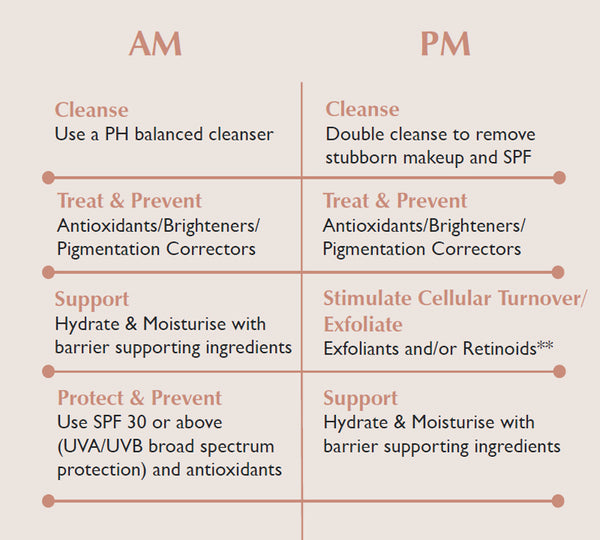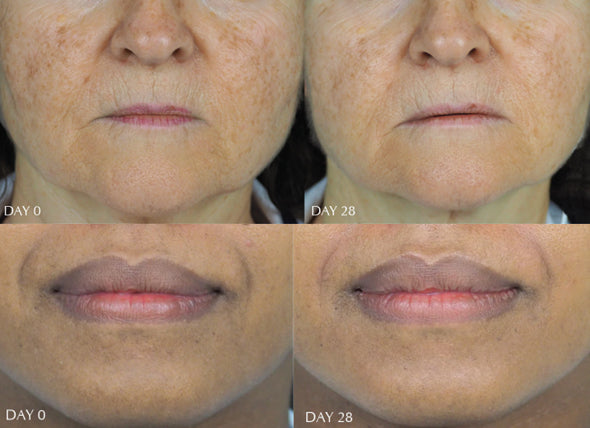Treating hyperpigmentation is an ongoing commitment to decrease the amount of excess melanin being produced and prevent its return especially in the cases of more genetic related hyperpigmentation disorders like Melasma. In the case of Post Inflammatory Hyperpigmentation (PIH), a hormonal blemish may settle in 2-3 weeks for darker skin tones but a dark blemish mark or dark spot itself can take months to fade. For some, post-acne marks can be more traumatic than the acne itself. While this does improve over a period of time, the fading process can take months or years requiring consistent and prolonged treatment.
Here are some key steps that can help you towards your journey for glowing, radiant, even skin tone.
Step 1: Measured Expectations
Patience: Some hyperpigmentation treatments can reveal results in less than 14 days whilst others produce optimal results over a period of time or 8-12 weeks for topical skin care in best cases. The reality for most however is treatment often requiring months to years; where one really needs to set the expectation that improvement is slow and recurrences are common.
Persistence: Since improvement can be slow and reoccurrences common, it is imperative that you follow your skincare regime for a minimum of 3 months with dedicated consistency supported by combination therapies (i.e. in-clinic treatments if needed). Results for topical skin care also depend on your genetically predetermined skin cell turnover, which decreases as we age. Staying consistent over a period of time, allowing your skin the time it needs to reveal change will be important.
Step 2: Prevention
One of the most effective ways to prevent and help fade hyperpigmentation is to ensure that you are using an SPF (SPF 30 and above). If you suffer from melasma, rebound hyperpigmentation and live in high UV index countries then looking for higher SPF protection a (SPF 50 and above) is often advised as some studies do show greater improvement in hyperpigmentation conditions when compared with sunscreens with SPF 30 (Mahmoud, B. H.,et al. 2010).
Using sunscreens should be an essential, non-negotiable step in any treatment protocol if you are serious about tackling hyperpigmentation. Sunscreens that include Zinc Oxide and Titanium Dioxide can also be less irritating on the skin for those who find using sunscreens or sunscreen filters irritating. Sunscreens with Iron Oxides are also an added bonus against HEV and Blue Light. The key here will be to find a sunscreen with a texture and finish that works for your skin so that you are comfortable using this daily as consistent use is what eventually leads to change.
In addition to sunscreen, remember protective clothing with UPF (Ultraviolet Protection Factor) also helps to protect against the sun's rays. For example, a UPF 50 fabric blocks 98 percent of the sun's rays and allows two percent.
Step 3: Skincare ingredients for an even skin tone routine
Whether you are looking to treat hyperpigmentation or you are under the effect of any of the triggering factors for hyperpigmentation (contraceptives, pregnancy, hormonal replacement therapy, summer season, post-depilation, post-acne etc.) a daily treatment and preventative routine can be beneficial. One that combines a multi-pathway depigmentation treatment with a high SPF protection can really help you maintain even skin tone.
The brightening ingredients that bring into effect the above pathways are:
Protection
SPF photo-protection, UVA/UVB BROAD SPECTRUM and antioxidantsTitanium Dioxide, modern Chemical filters, Turmeric, Superoxide Dismutase, Glutathione, Vitamin E, Resveratrol, Milk Thistle (Silymarin),Epigallocatechin Gallatyl Glucoside (green tea polyphenol), Moringa Seed Extract
Brighteners
Regulate excessive melanin production and transferHexylresorcinol, Dioic Acid, Kojic Acid, Brightening Peptides, Bakuchiol, Licorice Root Extract, Azelaic Acid, Emblica Officinalis, N-Acetyl Glucosamine, Alpha Arbutin, L Ascorbic Acid, Vitamin C Derivatives, Rumex Occidentalis Extract, Terminalia Chebula, Niacinamide, Soy
Barrier Support
Nourish, soothe & hydrate...Panthenol, Aloe Vera, Centella Asiatica, Boswellia Serrata
Retinoids
stimulate cell turnover, melanin transfer inhibitorsAll-Trans-Retinoic Acid, Retinaldehyde, Retinol, Retinol Retinoate, Retinyl Palmitate, Retinal Ester, Hydroxypinacolone Retinoate
Exfoliants
Help dislodge surface level pigmented skin cellsEnzymes, Mandelic Acid, Salicylic Acid, Glycolic Acid, Lactic Acid
The Best Ingredient Pairings for Brightening Skin
Brighteners + Retinoids
Niacinamide + Retinoids
Vitamin C + Retinoids
Licorice Root Extract + Retinoids
Brighteners + Exfoliants
Dioic Acid + Mandelic Acid
Niacinamide + BHA
Glucosamine + Retinoids
Brighteners + Barrier Support
Hexylresorcinol + Niacinamide + Silymarin
Azelaic Acid + Panthenol
Hexylresorcinol +Emblica Officinalis
Step 4 Build your even tone routine

Step 5 Clinical Treatments for Stubborn Hyperpigmentation
For stubborn pigmentation, especially dermis-deep ones resulting from acne scarring, clinical treatments administered by a dermatologist can be a fast and safe way to break up the pigmentation.
1. Chemical Peels
Chemical peels can be used to exfoliate the top outer layers of skin to renew the skin surface and reveal smoother skin beneath. This can lead to a few days of downtime whilst skin peeling and healing occurs. Peels can include Retinoic Acid, Glycolic Acid, Lactic Acid and TCA peel.
DARK SKIN TONE GUIDANCE
If you are darker in skin tone, look for multi acid treatments with your clinics that use Mandelic and Salicylic acid at higher percentages as these are gentler on the skin than smaller molecular-sized acids like Glycolic Acid or TCA peels and in return reducing the risk of hyperpigmentation. A professional will be able to guide you through what is best for your skin.
2. Lasers
Choosing a qualified professional will be essential when looking into laser treatments suitable for your skin to ensure you are choosing the right laser and most importantly the right setting for your skin (take note of the setting if you are hopping between clinics). Some lasers used to treat Hyperpigmentation include Nano and Pico lasers.
DARK SKIN TONE GUIDANCE
Those with darker skin tones need to be careful of any treatment procedure creating heat in the skin - as this has a higher chance of triggering further hyperpigmentation. Again darker skin tones will need to remain cautious and seek advice when looking into lasers to prevent severe adverse reactions. For example, avoiding treatments like Fraxel Lasers altogether unless specifically advised by your dermatologist.
3. Micro-needling
A process of creating microdamage using a needle on the superficial layer of skin can help with the absorption of brightening ingredients into the skin however some skins may notice temporary hyperpigmentation or further darkening of the skin due to the additional trauma caused by the needles puncturing into the skin.
4. Oral Treatments
Oral TA (Tranexamic Acid) is a relatively new ingredient in the west however in the east it has been used in cosmetics for over 10 years across products including hand creams. Although there is not a lot of evidence for topical application efficacy when used alone, oral TA shows promising results and may be an option to consider under the supervision of a professional due to reduce the risks of side effects associated with oral intake (Wang, J. V., et al. 2019). Just a note always seek professional and medical help from a service provider with existing knowledge of any health conditions before undertaking oral TA.
5. Other treatments
Personally I have never found Microdermabrasion and Intense Pulse Light to be incredibly effective however you may find these as alternative options that suit your skin and may be worth exploring with a professional.
Sachi Skin's Solution for Hyperpigmentation

As you can see hyperpigmentation is a complex issue, at Sachi Skin we’re dedicated to addressing it head-on., with a safe and clinically proven to brighten and fade solution We believe in nurturing your skin's overall health for lasting radiance and respecting diverse skin tone needs. With our Triphala Pigmentation Corrector you will notice a brighter skin tone in just 28 days and discolourations begin to fade. The serum is driven with its’ innovative biotechnology and non-traditional ingredients that can easily fit into any routine and layered alongside other ingredients readily like Vitamin A and Exfoliates to fade hyperpigmentation faster. We are here to help with any questions you might have in putting a routine together so please do reach out to us on customer service for routine guidance if you are still unsure.
Disclaimer: Please note none of the above constitutes medical advice. Always seek medical advice if you have any concerns or are looking to treat a medical condition.
References:
Wang, J. V., Jhawar, N., & Saedi, N. (2019). Tranexamic Acid for Melasma: Evaluating the Various Formulations. The Journal of clinical and aesthetic dermatology, 12(8), E73–E74.
Mahmoud, B. H., Ruvolo, E., Hexsel, C. L., Liu, Y., Owen, M. R., Kollias, N., Lim, H. W., & Hamzavi, I. H. (2010). Impact of long-wavelength UVA and visible light on melanocompetent skin. The Journal of investigative dermatology, 130(8), 2092–2097. https://doi.org/10.1038/jid.2010.95



